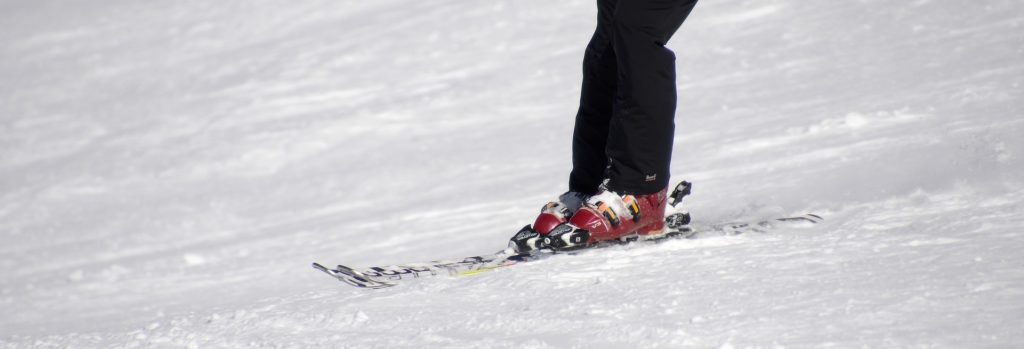If you’re a first-time skier, are looking to buy some new boots or just want to understand the lingo, you might have come across the words boot flex.
It is no surprise that your boots are one of the most important pieces of equipment which affect your skiing ability, growth as a skier and comfort during your trip.
Remember, these are the things you will likely be wearing all day every day so you need to make sure that they’re the right ones for you! With so many features which vary between boots and brands, its important to know what each one is and why it matters.
So, what is boot flex? And does boot flex really matter? Well, there are lots of ways boot flex can alter the feel of your boots and different factors which can help to determine what level of flex is right for you.
Ski Boot Flex 101
Ski boot flex is the ability of the boot to flex forwards under pressure. Stiffer boots have a higher flex rating and are suitable for more advanced and taller people. Boot flex is rated using an numbered index which indicates soft, medium, stiff and very stiff flex.
What is Ski Boot Flex?
Ski boot flex simply refers to how easy or difficult it is to flex the boot forwards. If you’ve ever worn ski boots before, you’ll notice that as your leg is angled forwards, the boot is able to flex to a certain degree when pressure is applied and to some extent, spring back slightly.
This feature can vary significantly between different brands or flex rating which can vary from being soft and easy to flex, to extremely stiff and difficult to flex at all.
There are a number of advantages to each style and knowing which type of skier is better suited to different levels of flex will help you to find the perfect boots for you!
Why Does Ski Boot Flex Matter?
The flex of your boot depends on a variety of factors but a boot with too much or little flex can cause discomfort or impact your level of control and technique when skiing.
For example, if your boot has too much flex for your ability and build, then your leg will be allowed to angle too far forward when pressure is applied, bending the knee more than is necessary. This can lead to fatigue and discomfort, especially if you’re doing plenty of skiing during your day or trip!
However, if the boot is too stiff for your ability or build, then the boot will restrict the movement of the leg and mean you have less control when turning.

How is Boot Flex Measured?
What is flex rating?
If you are concerned with boot flex, then you’ve likely come across the term flex rating. This is simply the numerical rating given to boots which indicate their level of flex, from soft flex which is given a lower rating, to still flex which is given a higher rating.
Generally speaking, this can range between 50 and 130, although as this increases, categories of flex may be different between brands or for men and women.
Does this vary between brands?
As flex isn’t measured in a constant way between brands, the range of the index each brand shows can be vastly different so it’s important you remember this when looking for a new pair of boots! For example, for one brand, a flex index of 80 could be the equivalent of an index of 100 or even more for another brand.
Some brands even use different ranges of numbers as their flex index, so make sure the check this with whatever brand you choose to go with to determine how their flex index might differ from what you’re used to.
Categories of Flex
Soft Flex
This is the softest level of boot flex available and generally has the lowest numerical flex index. This means that these boots have the lowest resistance when pressure is applied to flex them forwards. Similarly, these are likely to spring back the least.
These can be ideal for beginner skiers who are still getting used to new techniques and applying pressure to the front of their boots as well as being much easier to take on and off.
However, even beginner skiers may quickly require or want a boot with a stiffer flex to allow them to develop their technique, so make sure that these are the right boots for you if you’re looking to ski lots in the future!
Medium Flex
Medium flex boots are exactly as they are named, and often perfect for intermediate skiers or taller beginners. You might be developing your technique past the point of a brand new beginner skier or even want stiffer boots for your comfort or control.
If any of these sound like they might apply to you, then you might be wanting a medium flex boot.
Stiff Flex
Stiff flex boots are ideal for more experienced skiers or taller individuals who want more control over their skis and who have an advanced technique. Flex index for these boots can range between 90-125 on average, although this can change between different brands.
Expect these boots to be slightly more difficult to get on and off too!
Very Stiff Flex
Often some of the highest quality boots a brand for recreational skiers offer, very stiff flex boots are designed for very experienced individuals or even for racing. These will be at the very top of the flex index and offer little resistance to pressure.
These may also be appropriate for heavier or taller skiers and have the benefit of allowing precise control over movements and enhanced control. Above this level of flex are professional racing skis.
What can Affect what Boot Flex you Need?
Ability
Ability is one of the largest determining factors in deciding which level of flex your boots should have. The more advanced a skier you are, the higher speeds you are likely to be travelling on more challenging slopes with a more refined and advanced technique.
Stiffer boots are needed for advanced skiing techniques on more difficult slopes where high levels of control are needed over turning and precise movements.
Similarly, soft flex boots may allow a beginner skier, likely skiing on slower and easier slopes, to develop and learn at their level.
Check out this comparison between advanced and beginner ski boots to learn about all the other differences.
Height
Generally, as a persons height increases, they will require ski boots with a stiffer flex or higher flex index. This is due to the added pressure a taller individual will naturally apply on the boot, meaning that a stiffer boot will provide them with the appropriate level of control.
Terrain
The stiffer the boot becomes, the more suitable it is for steeper and more challenging slopes as well as off-piste slopes for advanced skiers.
For example, soft flex boots may be suited to shallow of even nursery slopes, whereas stiff and very stiff boots are suited to high speeds down black, black diamond, mogul or off-piste slopes.
Frequently Asked Questions
How do I know what flex my boots have?
Often, boots will display their flex index at the end of their name and also on the side of the boot itself. Remember that if your chosen brand has a flex index ranging between 50-130 for example, you’re looking for a number within this range.
Can you alter boot flex?
For many models of ski boots, they are designed with a fixed flex which simply varies between models. However, some brands do offer boots with adjustable flex so be sure to check this out if you would prefer boots which are more adaptable as your skiing ability improves.
Here are some more articles you might find useful:
